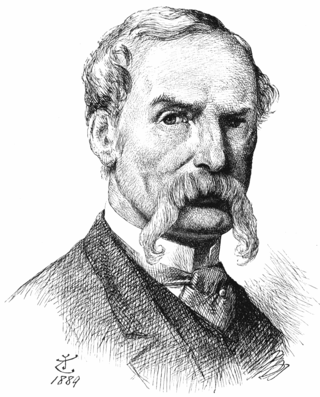
Sir John Tenniel was an English illustrator, graphic humourist and political cartoonist prominent in the second half of the 19th century. An alumnus of the Royal Academy of Arts in London, he was knighted for artistic achievements in 1893, the first such honour ever bestowed on an illustrator or cartoonist.

"Jabberwocky" is a nonsense poem written by Lewis Carroll about the killing of a creature named "the Jabberwock". It was included in his 1871 novel Through the Looking-Glass, the sequel to Alice's Adventures in Wonderland (1865). The book tells of Alice's adventures within the back-to-front world of the Looking-Glass world.

Through the Looking-Glass, and What Alice Found There is a novel published on 27 December 1871 by Lewis Carroll, a mathematics lecturer at Christ Church, University of Oxford, and the sequel to Alice's Adventures in Wonderland (1865). Alice again enters a fantastical world, this time by climbing through a mirror into the world that she can see beyond it. There she finds that, just like a reflection, everything is reversed, including logic.

Humpty Dumpty is a character in an English nursery rhyme, probably originally a riddle and one of the best known in the English-speaking world. He is typically portrayed as an anthropomorphic egg, though he is not explicitly described as such. The first recorded versions of the rhyme date from late eighteenth-century England and the tune from 1870 in James William Elliott's National Nursery Rhymes and Nursery Songs. Its origins are obscure, and several theories have been advanced to suggest original meanings.

Alice's Adventures in Wonderland is an 1865 English children's novel by Lewis Carroll, a mathematics don at Oxford University. It details the story of a girl named Alice who falls through a rabbit hole into a fantasy world of anthropomorphic creatures. It is seen as an example of the literary nonsense genre. The artist John Tenniel provided 42 wood-engraved illustrations for the book.
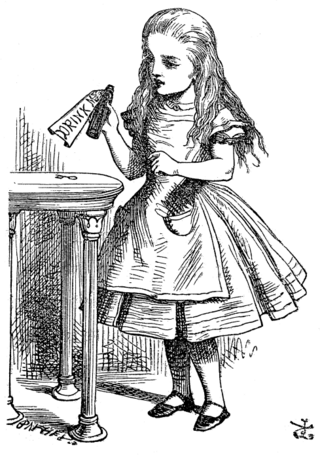
Alice is a fictional character and the main protagonist of Lewis Carroll's children's novel Alice's Adventures in Wonderland (1865) and its sequel, Through the Looking-Glass (1871). A child in the mid-Victorian era, Alice unintentionally goes on an underground adventure after falling down a rabbit hole into Wonderland; in the sequel, she steps through a mirror into an alternative world.

Alice Pleasance Hargreaves was an English woman who, in her childhood, was an acquaintance and photography subject of Lewis Carroll. One of the stories he told her during a boating trip became the classic 1865 children's novel Alice's Adventures in Wonderland. She shared her name with "Alice", the story's protagonist, but scholars disagree about the extent to which the character was based upon her.

A bandersnatch is a fictional creature in Lewis Carroll's 1871 novel Through the Looking-Glass and his 1874 poem The Hunting of the Snark. Although neither work describes the appearance of a bandersnatch in great detail, in The Hunting of the Snark, it has a long neck and snapping jaws, and both works describe it as ferocious and extraordinarily fast. Through the Looking-Glass implies that bandersnatches may be found in the world behind the looking-glass, and in The Hunting of the Snark, a bandersnatch is found by a party of adventurers after crossing an ocean. Bandersnatches have appeared in various adaptations of Carroll's works; they have also been used in other authors' works and in other forms of media.

Karoline Leach is a British playwright and author, best known for her book In the Shadow of the Dreamchild (ISBN 0-7206-1044-3), which re-examines the life of Lewis Carroll, the author of Alice's Adventures in Wonderland. This book and her subsequent work on what she terms the "Carroll Myth" have been major sources of upheaval and controversy in recent years and she has produced very polarized responses from Carroll scholars and lay enthusiasts.
Mischmasch was a periodical that Lewis Carroll wrote and illustrated for the amusement of his family from 1855 to 1862. It is notable for containing the earliest version of the poem "Jabberwocky", which Carroll would later expand and publish in Through the Looking-Glass. It was collected into The Rectory Umbrella and Mischmasch, published in 1932.

Lewis Carroll's books Alice's Adventures in Wonderland (1865) and Through the Looking-Glass (1871) have been highly popular in their original forms, and have served as the basis for many subsequent works since they were published. They have been adapted directly into other media, their characters and situations have been appropriated into other works, and these elements have been referenced innumerable times as familiar elements of shared culture. Simple references to the two books are too numerous to list; this list of works based on Alice in Wonderland focuses on works based specifically and substantially on Carroll's two books about the character of Alice.

An unbirthday is an event celebrated on all days of the year which are not a person's birthday. It is a neologism which first appeared in Lewis Carroll's 1871 novel Through the Looking-Glass. The concept gave rise to "The Unbirthday Song" in the 1951 animated feature film Alice in Wonderland.

The Looking Glass Wars is a series of three novels by Frank Beddor, heavily inspired by Lewis Carroll's 1865 novel Alice's Adventures in Wonderland and its 1871 sequel Through the Looking-Glass. The premise is that the two books written by Lewis Carroll are a distortion of the "true story".
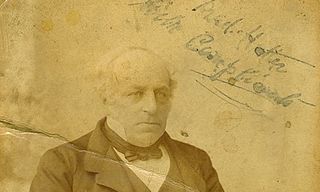
Theophilus Carter was an eccentric British furniture dealer who may have been an inspiration for the illustration by Sir John Tenniel of Lewis Carroll's characters the Mad Hatter in his 1865 novel Alice's Adventures in Wonderland and Hatta in the 1871 sequel Through the Looking-Glass.
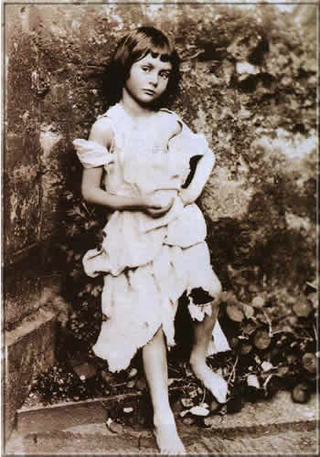
Through the Looking Glass is a chamber opera by the Australian composer Alan John to a libretto by Andrew Upton, based on Lewis Carroll's 1871 book and on the life of Alice Liddell, the girl for whom Carroll wrote the story's 1865 prequel, Alice's Adventures in Wonderland.
Sherry L. Ackerman is an American academic and dressage clinician.

Charles Lutwidge Dodgson, better known by his pen name Lewis Carroll, was an English author, poet, mathematician and photographer. His most notable works are Alice's Adventures in Wonderland (1865) and its sequel Through the Looking-Glass (1871). He was noted for his facility with word play, logic, and fantasy. His poems Jabberwocky (1871) and The Hunting of the Snark (1876) are classified in the genre of literary nonsense.

The Looking-Glass world is the setting for Lewis Carroll's 1871 children's novel Through the Looking-Glass.
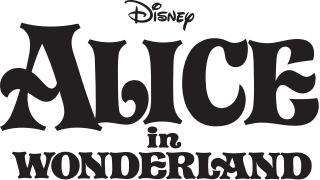
Alice in Wonderland, or simply Alice, is a Disney media franchise, commencing in 1951 with the theatrical release of the animated film Alice in Wonderland. The film is an adaptation of the books by Lewis Carroll, the 1865 novel Alice's Adventures in Wonderland and its 1871 sequel Through the Looking-Glass, which featured his character Alice. A live-action film directed by Tim Burton was released in 2010.
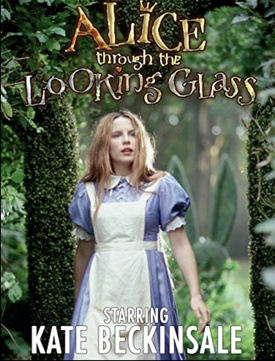
Alice through the Looking Glass is a 1998 British fantasy television film, based on Lewis Carroll's 1871 book Through the Looking-Glass, and starring Kate Beckinsale.

















